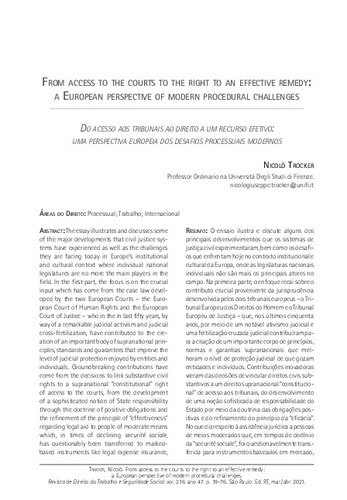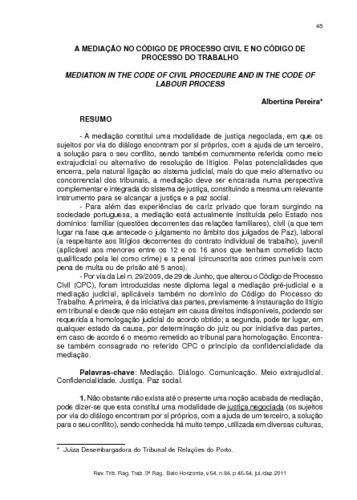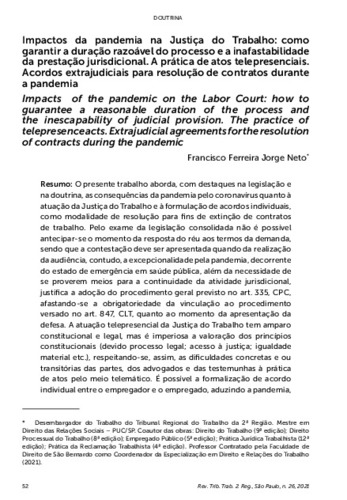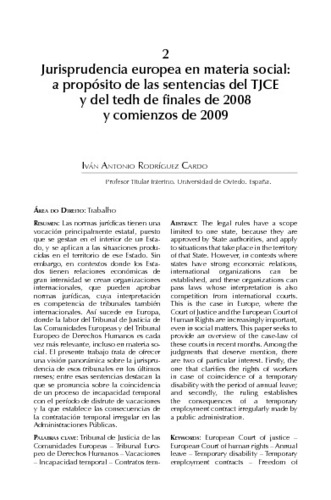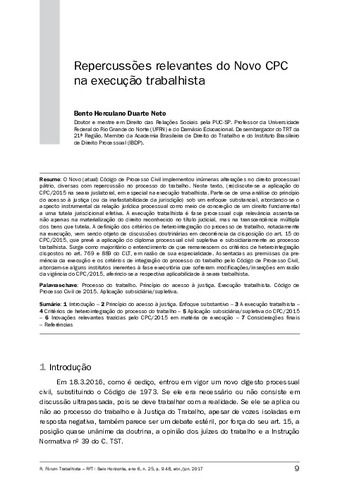Artigo de periódico
From access to the courts to the right to an effective remedy: a European perspective of modern procedural challenges
| dc.contributor.author | Trocker, Nicolò | |
| dc.date.accessioned | 2021-03-18T11:23:17Z | |
| dc.date.available | 2021-03-18T11:23:17Z | |
| dc.date.issued | 2021-04 | |
| dc.identifier.citation | TROCKER, Nicolò. From access to the courts to the right to an effective remedy: a European perspective of modern procedural challenges = Do acesso aos tribunais ao direito a um recurso efetivo: uma perspectiva europeia dos desafios processuais modernos. Revista de direito do trabalho e seguridade social, São Paulo, v. 47, n. 216, p. 19-76, mar./abr. 2021. | pt_BR |
| dc.identifier.uri | https://hdl.handle.net/20.500.12178/182992 | |
| dc.description.abstract | [por] Ilustra e discute alguns dos principais desenvolvimentos que os sistemas de justiça civil experimentaram, bem como os desafios que enfrentam hoje no contexto institucional e cultural da Europa, onde as legislaturas nacionais individuais não são mais os principais atores no campo. Na primeira parte, o enfoque recai sobre o contributo crucial proveniente da jurisprudência desenvolvida pelos dois tribunais europeus – o Tribunal Europeu dos Direitos do Homem e o Tribunal Europeu de Justiça – que, nos últimos cinquenta anos, por meio de um notável ativismo judicial e uma fertilização cruzada judicial contribuíram para a criação de um importante corpo de princípios, normas e garantias supranacionais que melhoram o nível de proteção judicial de que gozam entidades e indivíduos. Contribuições inovadoras vieram das decisões de vincular direitos civis substantivos a um direito supranacional "constitucional" de acesso aos tribunais, do desenvolvimento de uma noção sofisticada de responsabilidade do Estado por meio da doutrina das obrigações positivas e do refinamento do princípio da "eficácia". No que diz respeito à assistência jurídica a pessoas de meios moderados que, em tempos de declínio da "securité sociale", foi questionavelmente transferida para instrumentos baseados em mercado, como seguro de despesas legais, acordos de honorários condicionais e financiamento de litígios de terceiros. A parte central do ensaio apresenta as lições que podem ser extraídas do grande movimento de reforma na Europa na virada do novo milênio, onde alguns países promulgaram novos códigos e outros introduziram reformas que afetaram profundamente partes substanciais de seus sistemas processuais. Este é um exemplo notável de um diálogo construtivo entre legisladores nacionais que estão cada vez mais conscientes da necessidade de se olharem e de considerar o que está acontecendo em outros lugares para ver se é possível responder aos problemas de suas sociedades usando criticamente o que está sendo experimentado por outros, sem necessariamente recorrer à recepção passiva e imitação. Flexibilidade, proporcionalidade e cooperação entre as partes, seus advogados e o tribunal surgiram como os princípios norteadores da modernização dos procedimentos contenciosos. A parte final do ensaio aborda três dos objetivos mais complexos e contenciosos que os sistemas de justiça europeus ainda têm grande dificuldade em lidar: melhorar o acesso à informação e às provas em áreas do contencioso civil caracterizadas por formas estruturais de assimetria de informação; fortalecer a "função dissuasiva" dos recursos cíveis em situações como discriminação de gênero, onde interesses regulatórios eminentes estão em jogo; desenvolver mecanismos adequados de tutela coletiva em um ambiente ainda profundamente marcado por uma cultura individualista de litígio. | pt_BR |
| dc.description.abstract | [eng] The essay illustrates and discusses some of the major developments that civil justice systems have experienced as well as the challenges they are facing today in Europe’s institutional and cultural context where individual national legislatures are no more the main players in the field. In the first part, the focus is on the crucial input which has come from the case law developed by the two European Courts – the European Court of Human Rights and the European Court of Justice – who in the in last fifty years, by way of a remarkable judicial activism and judicial cross-fertilization, have contributed to the creation of an important body of supranational principles, standards and guarantees that improve the level of judicial protection enjoyed by entities and individuals. Groundbreaking contributions have come from the decisions to link substantive civil rights to a supranational "constitutional" right of access to the courts, from the development of a sophisticated notion of State responsibility through the doctrine of positive obligations and the refinement of the principle of "effectiveness" regarding legal aid to people of moderate means which, in times of declining securité sociale, has questionably been transferred to markedbased instruments like legal expense insurance, conditional fees agreements and third party litigation funding. The central part of the essay presents the lessons that can be derived from the great reform movement in Europe at the turn of the new Millennium where some countries enacted new codes and others introduced reforms which have deeply affected substantial parts of their procedural systems. This is a remarkable example of a constructive dialogue between national legislators that are more and more aware of the need to look at each other and to consider what is happening elsewhere to see if it possible to answer the problems of their societies using critically what is being experimented by others, without necessarily resorting to passive reception and imitation. Flexibility, proportionality and cooperation between parties, their lawyers and the court, have emerged as the guiding principles of modernizing litigation procedures. The final part of the essay addresses three of the more complex and contentious objectives that Europe’s justice systems still have great difficulty to handle: improving access to information and evidence in areas of civil litigation characterized by structural forms of information asymmetry; strengthening the "dissuasive function" of civil remedies in situations like gender discrimination where eminent regulatory interests are at stake; developing adequate collective redress mechanism in an environment still deeply marked by an individualistic litigation culture. | pt_BR |
| dc.description.tableofcontents | Linking civil rights to a "supranational" right of access to the courts. The vision of the European Court of Human Rights -- Cost barriers and the refinement of the right of access to the courts. State obligations and the principle of effectiveness -- The shrinking role of state funded legal aid in times of austerity driven policies. Risk diversification through market-based instruments: legal expense insurance, conditional fee agreements, third party litigation funding -- etween quality and efficiency: the many faces of the ADR movement and the right to judicial adjudication -- The quest for efficiency and the parties’ right to have their civil disputes adjudicated within "reasonable time". The scrutiny of the time requirement in the European case-law and its impact on the responsibilities of parties and courts in the conduct of civil proceedings -- Modernizing litigation procedures: The efforts and aims of national reforms at the turn of the new millennium. Flexibility, proportionality, and the principle of cooperation between parties, their lawyers and the court -- Dealing with cases "justly" and the parties’ right of access to information and evidence. The departure from the "nemo tenetur" principle. The input of the European Directives -- New challenges of modern civil litigation: tackling "information asymmetry" through pre-action disclosure. A "right of information" for prospective claimants -- From access to judicial adjudication of civil disputes to the right to an effective remedy: a key-feature of Europe’s judicial "constitution" -- European "ius commune" for provisional and protective relief and its "spill over" effect -- Civil liability and the remedy of compensation. Setting down rules for the determination of damages: the requirements of effectiveness and adequacy | pt_BR |
| dc.language.iso | en_US | pt_BR |
| dc.relation.ispartof | Revista de direito do trabalho e seguridade social: vol. 47, n. 216 (mar./abr. 2021) | pt_BR |
| dc.subject | European Court of Human Rights | pt_BR |
| dc.subject | Acesso à justiça, Europa | pt_BR |
| dc.subject | Litígio, financiamento, Europa | pt_BR |
| dc.subject | Solução de conflito, Europa | pt_BR |
| dc.subject | Jurisdição contenciosa, Europa | pt_BR |
| dc.title | From access to the courts to the right to an effective remedy: a European perspective of modern procedural challenges | pt_BR |
| dc.title.alternative | Do acesso aos tribunais ao direito a um recurso efetivo: uma perspectiva europeia dos desafios processuais modernos | pt_BR |
| dc.type.genre | Artigo de periódico | pt_BR |
| dc.identifier.rvbisys | 001191680 | |
| dc.relation.ispartoflink | https://hdl.handle.net/20.500.12178/182739 | pt_BR |
Coleção
-
Artigos9527


